Welcome to the Briggs and Stratton Single Cylinder OHV Repair Manual, your comprehensive guide for maintaining, repairing, and troubleshooting single-cylinder OHV engines.
1.1 Overview of the Manual’s Purpose and Scope
This manual provides comprehensive repair and maintenance procedures for Briggs and Stratton single cylinder OHV engines. Covering disassembly, inspection, troubleshooting, and reassembly, it’s designed for technicians and service personnel. The 179-page PDF offers detailed guidance for efficient and accurate repairs, ensuring optimal engine performance and longevity.
1.2 Importance of Proper Maintenance and Repair
Proper maintenance and repair ensure engine longevity, efficiency, and safety. Regular servicing prevents premature wear, reduces downtime, and maintains optimal performance. This manual helps users identify and address issues early, avoiding costly repairs; Adhering to its guidelines ensures reliable operation and extends the service life of your Briggs and Stratton single cylinder OHV engine effectively.

Understanding the Briggs and Stratton Single Cylinder OHV Engine
This section introduces the Briggs and Stratton single-cylinder OHV engine, covering its air-cooled design, overhead valve technology, and reliable performance. It provides an overview of its operation and key features.
2.1 Key Components of the Engine
The Briggs and Stratton single-cylinder OHV engine features essential components such as the cylinder block, piston, crankshaft, camshaft, valves, and overhead valve system. The air-cooled design includes a cooling system with fins for heat dissipation. These components work together to ensure efficient combustion, power generation, and reliable performance in various applications.
2.2 Basic Operating Principles
The Briggs and Stratton single-cylinder OHV engine operates on a four-stroke cycle: intake, compression, power, and exhaust. The overhead valve design improves efficiency by separating the intake and exhaust valves. The engine uses an air-cooled system with fins for heat dissipation and a carburetor for fuel delivery, ensuring reliable performance in small equipment applications.
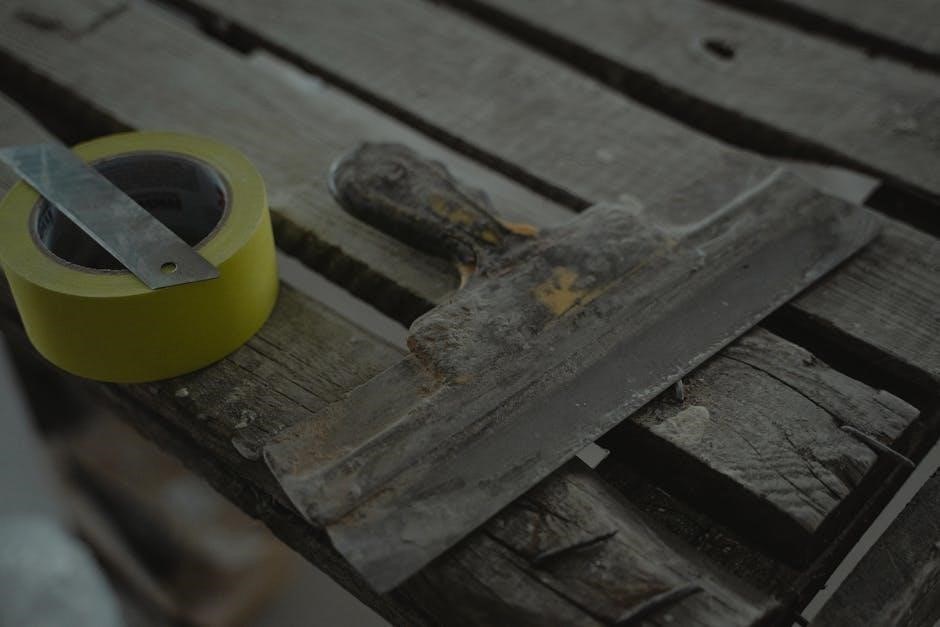
Essential Safety Precautions
Always wear protective gear, ensure proper ventilation, and avoid open flames. Disconnect the spark plug and relieve fuel pressure before starting repairs to ensure a safe working environment.
3.1 Personal Protective Equipment
Wear appropriate safety gear, including gloves, safety glasses, and a face mask, to protect yourself from potential hazards. Ensure proper fit and use of equipment to maintain safety throughout the repair process.
3.2 Safe Work Environment Setup
Ensure a well-ventilated, stable work surface for your Briggs and Stratton Single Cylinder OHV engine repair. Clear the area of debris and flammable materials. Use a fire extinguisher nearby. Keep tools organized and within reach. Maintain good lighting to prevent accidents. Always follow safety guidelines to protect yourself and others during the repair process.
Tools and Materials Required for Repair
Essential tools include wrenches, socket sets, piston ring compressors, and crankshaft pullers. Materials like gaskets, seals, and lubricants are necessary for a successful repair.
4.1 Specialized Tools Needed
Specialized tools include a piston ring compressor, crankshaft puller, and torque wrench. These tools are essential for safely dismantling and reassembling critical engine components without causing damage.
4.2 Common Materials for Repairs
Common materials for repairs include gaskets, seals, piston rings, and bearings. These components are essential for maintaining engine integrity and preventing leaks or friction damage. Ensure all materials meet OEM specifications for optimal performance and longevity of the engine.
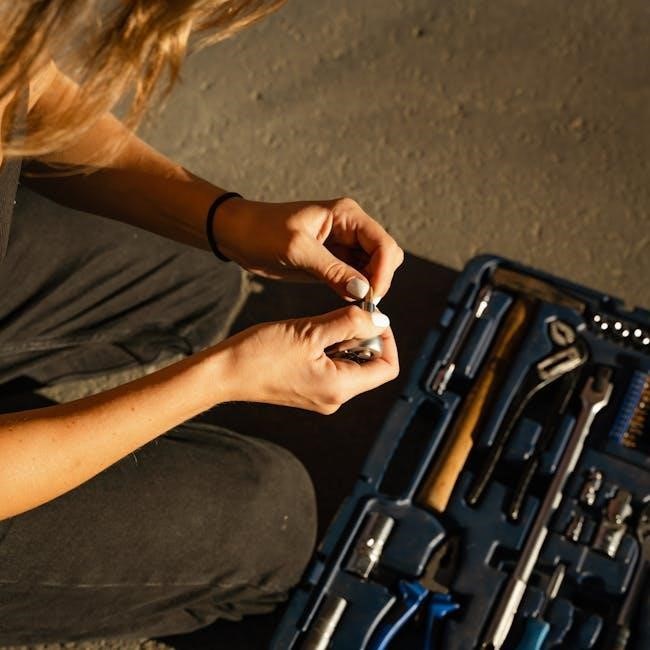
Step-by-Step Engine Disassembly
This section provides a detailed guide to safely disassembling the engine, including tools needed and precautions to ensure components are accessible for inspection and repair.
5.1 Removing the Cylinder Head
To remove the cylinder head, start by disconnecting the spark plug wire and any other components attached to the head. Drain the engine oil to prevent spills. Loosen the head bolts in a star pattern using a socket wrench until they are completely removed. Carefully lift the cylinder head off the engine block. If the head gasket is stuck, gently pry it loose with a plastic scraper to avoid damage. Set the head aside on a clean surface and inspect the mating surfaces for debris or old gasket material, cleaning them as needed for a proper seal during reassembly.
5.2 Accessing Internal Components
After removing the cylinder head, disconnect the intake manifold and carburetor to access the piston and crankshaft. Remove the timing cover and gears to expose the internal components. Use a puller to remove the flywheel and access the crankshaft. Carefully lift the piston assembly out of the cylinder bore, ensuring not to damage the bore or connecting rod. Inspect all components for wear or damage and document findings for necessary repairs or replacements. Properly label and store each part to maintain organization during reassembly.

Inspection and Diagnosis
Inspect the engine for wear, damage, or excessive carbon buildup. Perform compression tests to identify issues like low compression or faulty valves. Use diagnostic tools to pinpoint problems efficiently.
6.1 Identifying Common Issues
Identify common issues such as low compression, faulty valves, or worn piston rings. Look for symptoms like poor performance, excessive smoke, or unusual noises. Use diagnostic tools to confirm problems. Refer to the manual for troubleshooting charts and repair procedures tailored to Briggs and Stratton single-cylinder OHV engines.
6.2 Using Diagnostic Tools Effectively
Employ tools like compression testers and spark testers to diagnose engine issues. Use multimeters for electrical system checks. Analyze readings against manufacturer specifications. Refer to the manual’s troubleshooting charts for guidance. Proper tool usage helps pinpoint problems efficiently, ensuring accurate repairs for Briggs and Stratton single-cylinder OHV engines.

Repair and Replacement Procedures
This section outlines detailed steps for repairing or replacing critical components like pistons, crankshafts, and valve trains. Follow torque specifications and manufacturer guidelines for optimal performance.
7.1 Replacing the Piston and Rings
Begin by removing the engine and disassembling it to access the piston. Inspect for damage or wear. Remove the old piston rings using a ring compressor. Clean the cylinder wall thoroughly. Install new rings, ensuring proper alignment. Reattach the piston to the connecting rod. Apply oil to the piston and rings before reassembling the engine. Refer to the manual for torque specifications and alignment guidance.
7.2 Repairing or Replacing the Crankshaft
Remove the engine and disassemble it to access the crankshaft. Inspect for damage or wear. If damaged, use specialized tools to remove the old crankshaft. Install a new one, ensuring proper alignment. Secure it firmly and reassemble the engine step by step. Refer to the manual for specific torque specifications and alignment guidance to ensure optimal performance and longevity.
7.3 Overhauling the Valve Train
Begin by disassembling the valve train components, inspecting for wear or damage. Clean or replace parts as needed, ensuring proper clearance. Reassemble using torque specifications from the manual. Lubricate moving parts and test functionality. Specialized tools may be required for precise adjustments to restore optimal performance and prevent future issues. Follow step-by-step instructions for accuracy.
7.4 Servicing the Carburetor
Disassemble the carburetor, cleaning all components with a carburetor cleaner. Inspect for worn or damaged parts, replacing as necessary. Reassemble, ensuring proper alignment and gasket placement. Adjust the idle mixture screw for smooth operation. Refer to torque specifications and diagrams in the manual for precise reassembly. Test the engine to ensure optimal performance and fuel efficiency.
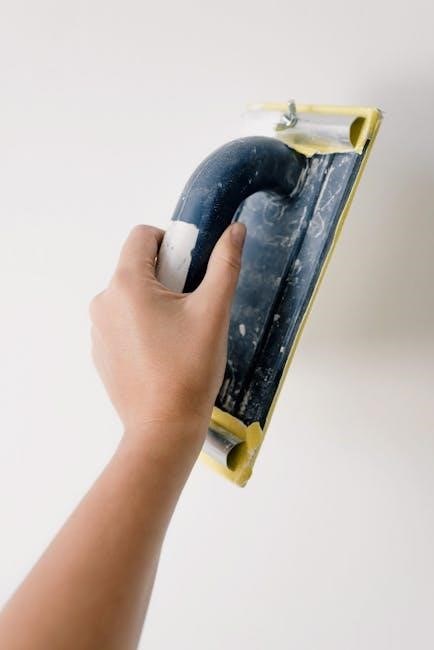
Engine Reassembly
Reassemble the engine carefully, following torque specifications and ensuring proper alignment of all components. Double-check connections and seals for leaks to ensure reliable engine operation.
8.1 Proper Torque Specifications
Proper torque specifications are critical during engine reassembly to ensure reliability and prevent damage. Always refer to the manual for exact values, as they vary by model. Use a torque wrench and follow the recommended sequence for components like cylinder head bolts, crankshaft bolts, and other critical fasteners. Over-tightening can lead to engine failure.
8.2 Ensuring Correct Alignment
Correct alignment is essential during engine reassembly to ensure smooth operation and prevent damage. Use alignment tools to properly position components like pistons, connecting rods, and crankshafts. Ensure the valve train components are accurately aligned using a feeler gauge. Misalignment can lead to poor engine performance or catastrophic failure. Always refer to the manual for specific alignment procedures and tolerances.
Post-Repair Testing and Adjustment
After reassembly, perform an initial startup to check for leaks and proper operation. Adjust idle speed, timing, and fuel mixture as needed for optimal performance.
9.1 Initial Startup and Idle Check
After completing repairs, ensure all connections are secure. Start the engine and allow it to run at idle. Check for leaks, unusual noises, or vibrations. Monitor the idle speed and adjust as necessary to maintain stability. Verify proper throttle response and ensure the engine operates smoothly without stalling.
- Ensure the air filter is clean and properly installed.
- Listen for any abnormal sounds indicating potential issues.
- Check the spark plug for proper firing and connection.
9.2 Fine-Tuning Engine Performance
After initial startup, fine-tune the engine by adjusting the carburetor for optimal idle and throttle response. Ensure the idle mixture screw is set for smooth operation without stumbling. Check and adjust the RPM to specifications using a tachometer. Verify proper ignition timing and spark plug performance. Make sure all connections are secure and free from leaks.
- Adjust the air-fuel mixture for maximum efficiency.
- Monitor engine temperature and ensure proper cooling.
- Inspect the valve train and ignition system for optimal performance.
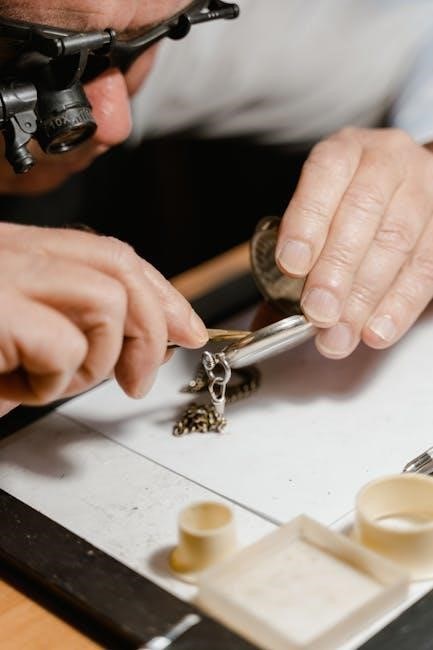
Preventative Maintenance
Regular inspections, oil changes, and air filter cleaning are essential. Check spark plugs and ensure proper torque on bolts. Follow manufacturer guidelines for extended engine longevity.
10.1 Regular Service Intervals
Regular service intervals are crucial for maintaining engine performance. Change oil every 50 hours or annually, clean or replace air filters, and inspect spark plugs. Check valve clearances and replace as needed. Follow the recommended schedule in the manual to ensure optimal engine operation and prevent potential issues. Consistent maintenance extends engine life and reliability.
10.2 Tips for Extending Engine Life
To maximize engine longevity, use the correct oil type and filter. Store the engine in a dry, clean environment and avoid extreme temperatures. Regularly inspect and clean cooling systems to prevent overheating. Keep the carburetor clean and ensure proper fuel quality. Address minor issues promptly to prevent major repairs. Proper storage and maintenance routines will significantly extend the engine’s lifespan.
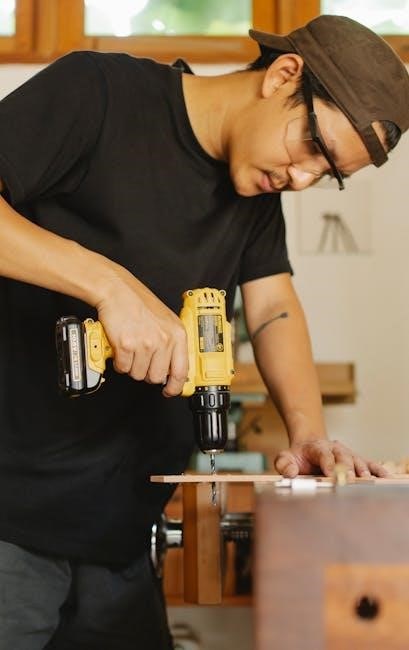
Troubleshooting Common Issues
Identify and address common problems like hard starting, poor performance, or overheating. Check air filters, spark plugs, and fuel systems. Refer to diagnostic charts for root causes and solutions.
11.1 Diagnosing Starting Problems
Identify issues like a faulty spark plug, empty fuel tank, or clogged air filter. Check the ignition system, fuel flow, and battery connections. Consult diagnostic charts to pinpoint root causes and apply corrective actions. Ensure proper choke operation and verify fuel quality. Refer to troubleshooting guides for step-by-step solutions to resolve starting difficulties effectively.
11.2 Resolving Performance Issues
Address poor engine performance by inspecting the fuel system, checking for blockages, and ensuring proper fuel flow. Verify the air filter is clean and the carburetor is functioning correctly. Check compression levels and ignition timing. Consult the repair manual for specific troubleshooting steps to restore optimal engine operation and efficiency.

Additional Resources
For further assistance, refer to official Briggs and Stratton documentation, online forums, and the 276781 instruction manual. Resources like ManualsLib offer downloadable PDF guides for detailed support.
12.1 Official Briggs and Stratton Documentation
The official Briggs and Stratton Single Cylinder OHV Repair Manual is a comprehensive 179-page guide available in PDF format. It covers detailed repair and maintenance procedures for single-cylinder OHV engines, including model-specific instructions for 276781 and other variants. This manual is a trusted resource for technicians, providing diagnostic guidance, troubleshooting tips, and torque specifications. It can be downloaded from trusted sources like ManualsLib or Issuu.
12.2 Online Communities and Forums
Online communities and forums provide valuable resources for Briggs and Stratton engine repair. Websites like ManualsLib and Issuu offer downloadable PDF manuals and repair guides. Additionally, forums dedicated to small engine repair allow users to share experiences, ask questions, and find solutions to common issues. These platforms are essential for DIY enthusiasts and professionals seeking real-world advice and troubleshooting tips.
